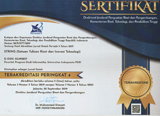Identifikasi Beban Kerja Melalui Penerapan Fisiologis Kerja Pada Pekerja Sentra Industri Sepatu
(1) Universitas Singaperbangsa Karawang
(2) Universitas Singaperbangsa Karawang
(*) Corresponding Author
Abstract
Healthy, safe and comfortable working conditions need to be created to increase work productivity, ergonomic aspects of the work environment need to be considered so that workers perform their duties optimally. Worker complaints can indicate that there is an unbalanced physiological workload, it is necessary to measure workload at the industrial center. The shoe industry center is one of the largest centers but the production process is still conventional, all work activities are carried out in a sitting and bending position. The aim of this research to identify the workload of workers and measure and analyze the level of fatigue using the ergonomic approach method physiologically workers. The results showed the% CVL of workers in the range of 16.5% - 21.2% which indicates there is no fatigue in workers, while the Energy Consumption (KE) of workers has a value of 1.265 which shows the physiological workload classification is very light, with oxygen consumption (V02) in the range of values 0.7-0.8 which indicates work in the shoe industry center is a medium work classification.
Key Words : Workloads, Ergonomics, Physiological Workload, Muscoletal Disrorder’s (MSD)
Keywords
Full Text:
PDFReferences
M. A. Bora, “Usulan Desain Laboratorium Perancangan Sistem Kerja & Ergonomi di Program Studi Teknik Industri STT Ibnu Sina Batam,” J. Tek. Ibnu Sina, vol. 2, no. 2, pp. 1–7, 2017.
A. Kristanto and D. A. Saputra, “Perancangan Meja dan Kursi Kerja yang Ergonomis pada Stasiun Kerja Pemotongan Sebagai Upaya Peningkatan Produktivitas,” J. Ilm. Tek. Ind., vol. 10, no. 2, pp. 78–87, 2011.
R. Z. Surya, R. Badruddin, and M. Gasali, “Aplikasi Ergonomic Function Deployment (EFD) pada Redesign Alat Parut Kelapa untuk Ibu Rumah Tangga,” J. Optimasi Sist. Ind., vol. 13, no. 2, p. 771, 2016.
M. Mutia, “Pengukuran Beban Kerja Fisiologis dan Psikologis pada Operator Pemetikan Teh dan Operator Produksi Teh Hijau di PTMitra Kerinci,” J. Optimasi Sist. Ind., vol. 13, no. 1, p. 503, 2016.
T. Sumarningsih, M. A. Wibowo, S. Prabandiyani, and R. Wardani, “International Journal of Science and Engineering ( IJSE ) Ergonomics in Work Method to Improve Construction Labor Productivity,” Int. J. Sci. Eng., vol. 10, no. 1, pp. 30–34, 2016.
P. Fithri and W. F. Anisa, “Pengukuran Beban Kerja Psikologis dan Fisiologis Pekerja di Industri Tekstil,” J. Optimasi Sist. Ind., vol. 16, no. 2, p. 120, 2017.
N. A. Silviana, “Penilaian Postur Kerja PekerjaDengan Menggunakan Metode REBA dan Biomekanika,” no. 1, pp. 10–16, 2016.
K. H. E. Kroemer, H. J. Kroemer, and K. E. Kroemer Elbert, Engineering Psysiology Bases of Human Factors Engineering/Ergonomics Fourth Edition. 2010.
L. Ruslani and Nurfajriah, “Analisis Beban Kerja Fisiologi dan Psikologi Karyawan Pembuatan Baju di PT Jaba Garmindo Majalengka,” Bina Tek., vol. 11, no. 2, pp. 114–123, 2015.
A. Shariat, J. A. Cleland, M. Danaee, M. Kargarfard, B. Sangelaji, and S. B. M. Tamrin, “Effects of stretching exercise training and ergonomic modifications on musculoskeletal discomforts of office workers: a randomized controlled trial,” Brazilian J. Phys. Ther., vol. 22, no. 2, pp. 144–153, 2018.
S. Siswiyanti and R. Rusnoto, “Penerapan Ergonomi pada Perancangan Mesin Pewarna Batik untuk Memperbaiki Postur Kerja,” J. Optimasi Sist. Ind., vol. 17, no. 1, p. 75, 2018.
A. D. Sari, M. R. Suryoputro, M. D. Pramaningtyas, P. S. Putra, and S. B. Maulidyawati, “Work Physiology Evaluation of Laundry Workers,” IOP Conf. Ser. Mater. Sci. Eng., vol. 105, no. 1, pp. 0–6, 2016.
H. S. Setiawan, “Pengaruh Ergonomi dan Antropometri bagi User Gudang Bahan PT. MI guna Meningkatkan Produktivitas Serta Kualitas Kerja,” STRING (Satuan Tulisan Ris. dan Inov. Teknol., vol. 2, no. 2, p. 161, 2017.
R. Yilmaz, H. Ero?lu, H. Cihan, and Y. Kayacan, “Determination of Physiological Workloads of the Harvesting Workers: A Case Study from Artvin,” Int. Cauc. For. Symp., no. m, pp. 152–159, 2013.
P. Yoopat, P. Toicharoen, T. Glinsukon, K. Vanwonterghem, and V. Louhevaara, “Ergonomics in practice: Physical workload and heat stress in thailand,” Int. J. Occup. Saf. Ergon., vol. 8, no. 1, pp. 83–93, 2002.
S. Borah, “Physiological Workload of Hill Farm Women of Meghalaya, India Involved in Firewood Collection,” Procedia Manuf., vol. 3, no. Ahfe, pp. 4984–4990, 2015.
DOI: http://dx.doi.org/10.30998/string.v5i1.6249
Refbacks
- There are currently no refbacks.
Copyright (c) 2020 Asep Erik Nugraha, Rianita Puspa Sari

This work is licensed under a Creative Commons Attribution 4.0 International License.
STRING (Satuan Tulisan Riset dan Inovasi Teknologi) indexed by:

Ciptaan disebarluaskan di bawah Lisensi Creative Commons Atribusi 4.0 Internasional.
View My Stats

 Sertifikat Akreditasi
Sertifikat Akreditasi
















